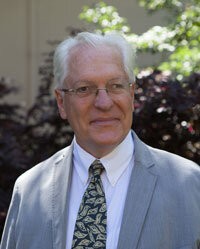
Gabriel Meyer
Professional Background
Gabriel Meyer is an award-winning novelist, poet, and journalist. A resident of Jerusalem’s Muslim Quarter in the 1980s, he won Catholic Press Association awards for his coverage of the first Palestinian intifada in 1989. He also traveled widely in the Middle East, particularly in Egypt and Turkey, covering the plight of the ancient Christian communities in the region.
Assigned to write on Yugoslavia for the National Catholic Register in 1990, he lived in Bosnia-Herzegovina and chronicled the region’s descent into civil war. Meyer returned frequently to the Balkans during the Bosnian war, writing principally on the plight of war orphans and the politics of aid. His reporter’s diary series on the last day of the war in Sarajevo (Oct. 1995) was nominated for several journalism awards.
Meyer published two novels in 1994: “In the Shade of the Terebinth” (Ave Maria Press, Notre Dame) and “The Gospel of Joseph” (Herder and Herder, New York).
In 1997, he met and interviewed legendary human rights champion Macram Max Gassis of Sudan and traveled with him to the Nuba Mountains in central Sudan the following year. Subsequent trips to Sudan in 1999, 2000, and 2001 provided the basis for a feature-length documentary “The Hidden Gift” on the Nuba and other “forgotten” peoples of Sudan’s civil war, which Meyer wrote.
Meyer returned to Sudan in 2004 with fine arts photographer James Nicholls. The two collaborated on a book of essays and photographs entitled “War and Faith in Sudan” published by William B. Eerdmans (Grand Rapids, MI). The book, released in 2005, won the National Association of Librarians’ ForeWord Magazine “Book of the Year” Award for essays in 2006.
Meyer has lectured widely in the United States and Europe, including major addresses at the United States Holocaust Memorial Museum in Washington, DC (on the nature of genocide), Notre Dame University, the Pontifical Gregorian University in Rome, and the Skirball Cultural Center in Los Angeles. He delivered the prestigious 2007 Medart Lecture on Catholic social thought at Maryville University in St. Louis. He has been a frequent guest on radio and television programs, including NPR-affiliate KCRW’s “Politics of Culture,” and C-SPAN 2’s BookTV.
In 2006, Meyer received a grant from the Dan Murphy Foundation to write a history of Jerusalem’s Church of the Holy Sepulcher. At the end of 2006, Meyer returned to Jerusalem to do research on the church. He secured permission from church authorities to visit the “hidden” areas of the site – e.g., the underground Roman/Byzantine “Cisterns of St. Helena,” the so-called Chapel of St. Vartan area beneath the ancient basilica, and excavation sites behind Calvary and beneath the Greek Katholikon, which are off-limits even to most scholars, giving him a uniquely well-informed and incisive perspective on the complex archaeological and historical questions associated with the church. He has since written a historical overview of the Church of the Holy Sepulcher entitled “The Testimony of Stones: A Biography of the Church of the Holy Sepulcher, Jerusalem.”
Meyer’s poetry was featured in Los Angeles Literary Review #2 (Red Hen Press, Pasadena, CA) in 2006. Tebot Bach Press (Los Angeles) published his major poetry cycle “A Map of Shadows” in 2012. He is currently editing a collection of his Bosnian war poetry entitled “Dreaming of Wheat.”
Meyer has also written extensively on the thought of British art and social critic John Ruskin and, since 1998, has been president, and now executive director of the Ruskin Art Club, Los Angeles’s oldest cultural and arts association (1888).
A Greek-Catholic, Meyer currently serves as cantor of St. Andrew Russian Greek-Catholic Church in El Segundo, California. He also serves as executive director of the Southern California Ecumenical Council, now renamed the Southern California Christian Forum. In the 1970s and early 1980s, he helped found one of the most influential covenant communities associated with the Catholic charismatic renewal, City of the Lord – a community headquartered in Tempe, Arizona, and with branches in Los Angeles, San Diego, and Monterrey.
In the 1960s, Meyer studied composition and piano at the New England Conservatory of Music in Boston.
Mr. Meyer lives in Los Angeles.
